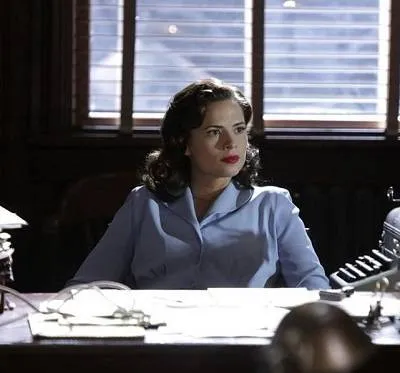
Marvel’s Agent Carter: A Story of Her Own
Everybody loves Peggy Carter.
Wait, that’s not true. This is the Internet, the place where the answer to a question that starts out with, “Am I the only one who hates….?” is never, ever, “Yes.”
Let me start again.
Peggy Carter, the character first portrayed by Hayley Atwell in 2011’s Captain America: The First Avenger, is a flawless human.
Now we’re getting closer. Technically, there may be no such animal, but “flawless human” is a label that fans in certain circles (let’s say, just for instance, on tumblr dot com) like to apply to the real or fictional objects of their admiration. Partly, this is a reaction to the Internet’s aforementioned tendency to hate things just for the fun of it, and partly it’s a declaration of defiance; the existence of the term Mary Sue reminds us that ‘perfect’ is the most dangerous thing for a female character to be.
Peggy Carter, in her First Avenger role as Steve “Captain America” Rogers’ contact in the Secret Science Reserve — his friend, potential dance partner, and plot-convenience enabler — may not be perfect, but she is certainly smart, successful, and tough. Yet something in the character’s very toughness points to a flaw, not in Peggy, but in the film’s design.
In 2013, Sophia McDougall wrote an article in The New Statesmen called I Hate Strong Female Characters, and while I don’t agree with all of it, I find the section about Peggy Carter to be uncomfortably resonant. McDougall points to two scenes in the film — one where Peggy punches a male soldier for mouthing off to her, and another where Peggy, upset because Steve flirted with another woman, shoots at his shield. Both of these scenes are played for laughs — I confess I find them funny myself — but the laughter is rooted in the notion that a woman committing serious violence in response to small provocation is amusing. “She is small and feminine and yet can defend herself,” we are supposed to think. “This is unexpected and kind of sexy!” These scenes demonstrate, McDougall argues, “the underlying deficit of respect the character starts with.”
The premiere episode of Marvel’s Agent Carter, the ABC miniseries that marks Atwell’s triumphant return to the role of Peggy, revisits that scene of Peggy shooting at the shield. It also contains the follow up image, of Steve Rogers and Howard Stark, looking surprised and unmistakably turned on by what Peggy just did.
That’s the male gaze, made literal and splashed across the screen for all to see. On Agent Carter, though, this scene and other flashbacks are interspersed with shots of Peggy, getting dressed alone in her room. And yes, we’re shown Peggy pulling on her stockings, but we’re also given a glimpse of her shoulder and its scarred over bullet wound. The message is unmistakable: this is Peggy Carter beneath the armor. These are the wounds she doesn’t show to the world.
That’s the simple, transformational truth about Agent Carter. This is the first live action Marvel drama with a story built around the needs and skills and desires of a central female character. In 1946, Peggy is working in the New York office of SSR, with one seemingly nice guy (I’m not ruling out that you might be a traitor, Enver Gjokaj! Also, I love your sweater vests!) and a lot of jerks.
When her old war buddy Howard Stark (Dominic Cooper, reprising his delightful First Avenger role) gets in trouble, he asks for help. Soon, she’s double-timing her official job, running counter missions in tandem with Stark’s butler, Jarvis (James D’Arcy).
The escalating spy hijinks are all great fun, especially Atwell’s back-and-forth with D’Arcy. But what’s especially good to see is the way Peggy carries the weight of her own story. If The First Avenger framed Peggy as an accessory to Steve’s heroic journey, Peggy is ready to see the tragedy as her own. He’s lost because she failed. When a waitress friend (Lyndsy Fonseca) tries to persuade Peggy to move into her all-female boarding house, Agent Carter hesitates because She Must Keep the Others Safe. (The episode shows that this is not a baseless fear) Later, it’s Jarvis who gives her the speech about how heroes can’t be loners and need to give and receive support from others.
Peggy gets all the hero angst, in other words, and she also gets the frustration of being disrespected by her male supervisors. She whacks bad guys in the face with a handy briefcase, and threaten a guy’s life with a fork, but she also explains to Maybe-Nice coworker that she is capable of picking her own battles. This is a much more subtle Peggy than the character who punched that soldier in the movie, and the story is richer for it.
This definitely isn’t a perfect show. Despite Peggy’s centrality, it’s still kind of a sausage fest, though hopefully Peggy’s new living arrangement will improve that. Agent Carter is also, not-unexpectedly but still depressingly, very white. The only character of color with a speaking part is a criminal (Andre Royo, aka The Wire‘s Bubbles, sadly underused) who dies early in the first hour. It would be great to see Gabe Jones, the African-American Howling commando that comics universe Peggy eventually dated. Maybe if this miniseries does well enough to inspire sequels in whatever medium, Derek Luke can show up to reprise that role from First Avenger, but for now, it would be nice to show more of the reality of 1940s New York.
The Marvel Cinematic Universe still has a diversity problem. Marvel can do more, and Marvel can do better. For now, it’s great to see Agent Carter in the center of her own story. It’s not flawless, but it’s a start.














